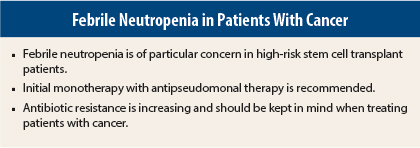Febrile neutropenia is of particular concern in high-risk patients who have undergone stem cell transplant, according to William J. Hogan, MB, BCh, Assistant Professor of Medicine at the Mayo Clinic in Rochester, Minnesota. Dr. Hogan delivered an update on febrile neutropenia management in this population at the 2015 Multinational Association of Supportive Care in Cancer/International Society of Oral Oncology (MASCC/ISOO) International Symposium on Supportive Care in Cancer, held recently in Copenhagen.1
Who Is at Risk?
Neutropenia is often defined as an absolute neutrophil count < 1,500 ´ 106/L. Those with severe neutropenia—an absolute neutrophil count < 500 ´ 106/L and especially < 100 ´ 106/L—are particularly at risk. Prolonged neutropenia generally refers to a duration of 7 days or longer.
According to Dr. Hogan, certain populations are at greater risk for neutropenia-related poor outcomes. Patients undergoing therapies sufficient to impact myelopoiesis and gastrointestinal integrity, such as induction chemotherapy for acute leukemia or myeloablative conditioning regimens, are in that high-risk cohort.
Additionally, neutropenia tends to be of particular concern in patients with refractory leukemia requiring multiple induction attempts. “This leaves patients very vulnerable to neutropenic fever and the consequence of neutropenic sepsis,” he stated. “Delayed engraftment or graft failure after transplant is also associated with very significant risk.”
Finally, patient-specific factors such as greater comorbidities and advanced age put patients at higher risk for poor outcomes. “Studies show that half of those patients with four comorbidities die in the hospital with neutropenic fever, so this really is a serious medical issue,” said Dr. Hogan. “Part of the issue is getting the patients to medical care quickly, and even when they get there, there are often extended delays before they get their first dose of intravenous [IV] antibiotics. So we really have to do better.”
Principles of Effective Management
Dr. Hogan recommended triaging the patient quickly, assessing for risk, and instituting therapy immediately (< 60 minutes) for high-risk patients. Risk assessment is crucial, as it determines patient prognosis and management (ie, inpatient vs outpatient, intensive care unit [ICU] vs non-ICU, and necessity and choice of IV antibiotics). “There are a number of risk assessment scores available, but the MASCC risk index scores are very useful,” he added.2
Next, consider sepsis protocol and transfer to the ICU if necessary, he told the audience. “If a patient has hypotension, hypoxia, change in mental status, or increased lactate, he or she is at high risk and needs urgent assessment and consideration for ICU care,” he advised. Finally, consider the prophylaxis used and prior colonization to determine antibiotic choice. “Also consider local resistance patterns based on your previous antibiotic use and what you see typically,” Dr. Hogan added. “That helps inform the decision about prophylaxis choices as well.”
Additionally, Dr. Hogan recommended a diagnostic evaluation performed through a thorough history assessment and clinical exam, appropriate labs (complete blood cell count, chemistry, markers of sepsis, organ function), cultures (peripheral blood and catheter, urine), and imaging. “Imaging can be misleading in patients with neutropenia because they don’t have white cells to provoke an inflammatory response; so radiologic imaging of the chest may not be as quickly positive as it is in non-neutropenic patients,” he warned. “Also, urine may not show pyuria in the absense of neutrophils, so you do have to bear these things in mind.”
Initial Antimicrobial Regimen
As to an initial antimicrobial regimen for febrile neutropenia, “there are regional differences, but, in general, initial monotherapy with antipseudomonal therapy is recommended,” said Dr. Hogan.
“Cefepime has been our standard because it offers excellent gram-negative coverage and quite good gram-positive coverage. Meropenem and imipenem are excellent drugs, and we tend to use piperacillin/tazobactam more on patients with risk factors for anaerobic infection.”
Consider double–gram-negative coverage for a complicated presentation (addition of a quinolone if not used for prophylaxis or an aminoglycoside), and expand gram-positive coverage (eg, with vancomycin) if there is a soft-tissue or central-line infection. If there is clinical evidence for anaerobic infection from neutropenic enterocolitis or perirectal infection, then anaerobic cover could be an important part of the regimen as well, he advised.
Modifications to Initial Therapy
If the patient is hemodynamically unstable, broadening the coverage to include resistant organisms and fungi might be necessary (especially if > 5 days of fever, prolonged neutropenia). But keep in mind that persistent fever may not require a change in therapy—consider other etiologies (eg, fungal, viral) and noninfectious causes (eg, malignancy, drugs, engraftment). Positive culture results may require expansion or modification based on the organism or resistance pattern.
“One question that comes up frequently is whether to remove the central catheter in a patient with infection,” said Dr. Hogan. The catheter can frequently be salvaged, but its removal should be considered if any of the following conditions is present:
- Catheter culture result becomes positive significantly before peripheral cultures.
- Persistently positive cultures do not clear.
- The patient has sepsis, tunnel infection, or endocarditis.
- Specific organisms known to be difficult to clear in the presence of a catheter (Pseudomonas aeruginosa, Staphalococcus aureus, rapidly growing mycobacteria, Candida spp) are present.
“Antibiotic resistance has become a reality for all of us,” said Dr. Hogan. The most common antibiotic-resistant bacteria are vancomycin-resistant enterococci, methicillin-resistant Staphylococcus aureus (MRSA), extended-spectrum beta-lactamase–producing bacteria (ESBL), and Klebsiella-producing carbapenemase.
“[Klebsiella-producing carbapenemase] is a challenging problem,” he added. “This is a very virulent, highly resistant organism. It may be responsive to tigecycline, but the options for treating it are very limited, so we need to try and prevent it from spreading.” ■
Disclosure: Dr. Hogan reported no potential conflicts of interest.
References
1. Hogan W: Febrile neutropenia: An update of management of high risk stem cell transplantation patients. 2015 MASCC/ISOO International Symposium on Supportive Care in Cancer. Parallel Session PS05. Presented June 26, 2015.
2. Multinational Association of Supportive Care in Cancer: Identifying patients at low risk for FN complications: Development and validation of the MASCC Risk Index Score. Available at www.mascc.org/mascc-fn-risk-index-score. Accessed September 2, 2015.



